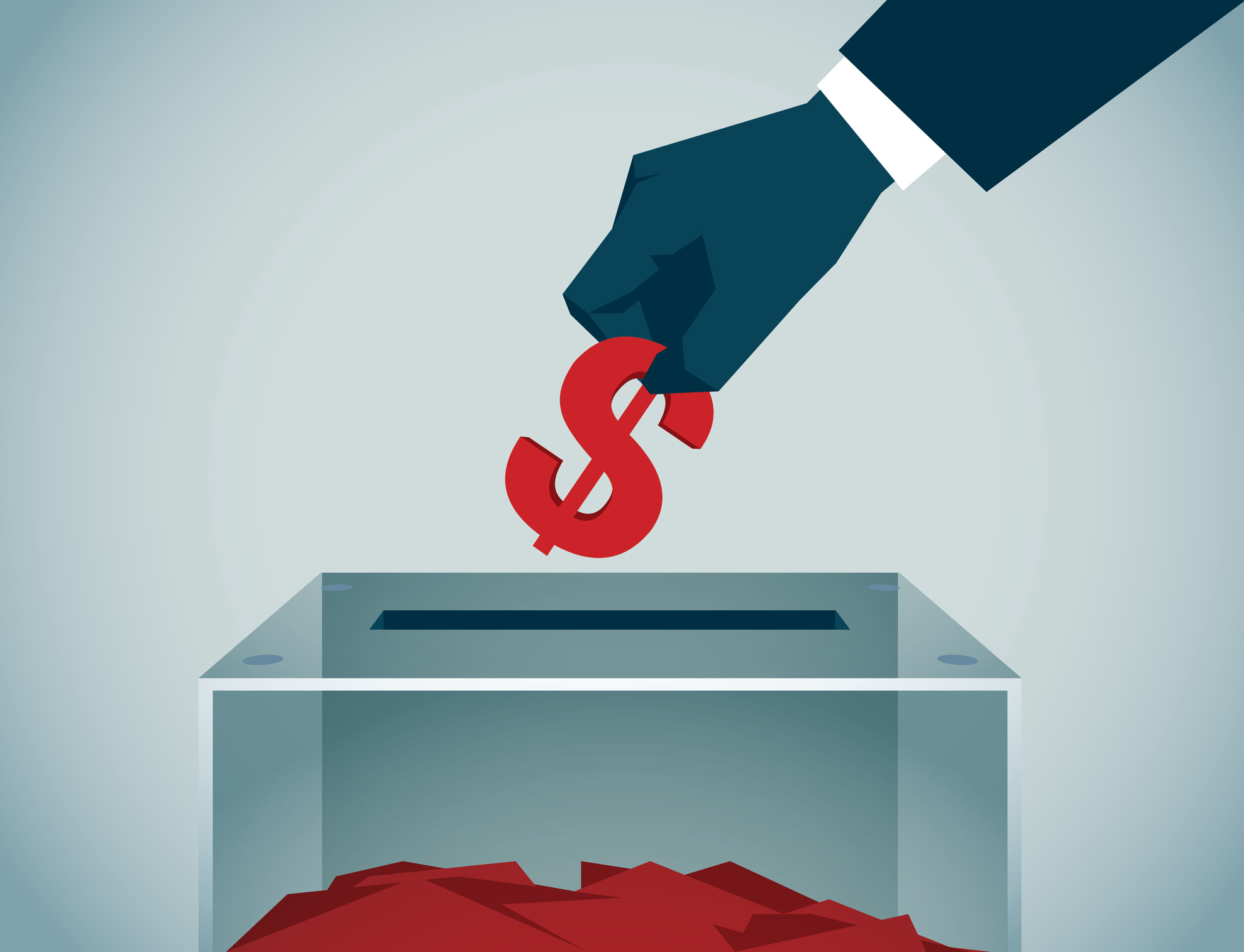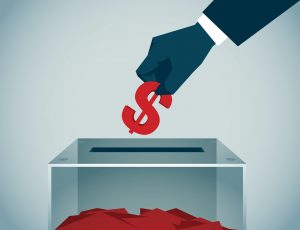Does direct democracy make regulatory capture harder for industry? Samantha Eyler-Driscoll looks at a new Stigler Center working paper that examines state-level referenda and initiatives from 1904 to 2017; it finds that economic interests are largely on the defensive when these types of popular measures go on the ballot.
To the great mortification of Switzerland’s domestic banking sector, on June 10 Swiss voters will head to the polls to decide on an initiative that could radically hobble local lending. The Vollgeld (sovereign money) Initiative has taken advantage of the country’s famously liberal system of referenda and popular initiatives—the former can be brought to a public vote with just 50,000 signatures to a petition launched by any citizen voter and the latter with 100,000—to propose a ban on fractional reserve banking and restrict money creation to the Swiss National Bank alone. Should the initiative pass, banks will no longer be allowed to expand the money supply electronically through lending—the origin of 90 percent of Switzerland’s current money supply.
Swiss banking executives have called the initiative—designed, according to its supporters, to reduce financial volatility and bring banks to heel—“an unnecessary and dangerous experiment.” Meanwhile, on VoxEU, economist Philippe Bacchetta of the University of Lausanne writes, “It is a weakness of the Swiss democratic system that citizens can vote on economic initiatives in the absence of … [thorough economic] analysis.”
New research by John Matsusaka of the University of Southern California, however, suggests that the sequestering of economic policymaking from special interest influence may be precisely what direct democracy is for. His latest Stigler Center working paper works from theories of how regulatory capture operates on the representative institutions of democracy and seeks to answer the question: “Does special interest influence decline when policy is chosen using direct democracy?” More specifically, Matsusaka examines whether business interests are most often helped or hurt by the passage of state initiatives and referenda (I&R).
|
Woodrow Wilson argued that I&R are “a means of bringing our representatives back to the consciousness that what they are bound in duty and in mere policy to do is to represent the sovereign people” in the face of “the control of politics and of our life by great combinations of wealth.” |
The idea that I&R could serve to check the excess influence of concentrated economic power goes back to the formative days of direct democracy in 20th-century America, Matsusaka explains. “The initiative and referendum … are so framed that if the legislatures obey the command of some special interest, and obstinately refuse the will of the majority, the majority may step in and legislate directly,” Theodore Roosevelt said in speech in 1912. That same year, Woodrow Wilson argued that I&R are “a means of bringing our representatives back to the consciousness that what they are bound in duty and in mere policy to do is to represent the sovereign people” in the face of “the control of politics and of our life by great combinations of wealth.”
Modern theories of political economy offer a strong basis to believe that Roosevelt, Wilson, and their ilk may have been onto something. Olson’s (1965) Logic of Collective Action outlined how democratic politics incentivizes intense organizing action by small groups to influence the legislative process and can lead to policy outcomes that run counter to the preferences of the majority. Stigler (1971) extended this logic with his theory of regulatory capture and opened the way for an enormous literature on the mechanisms industry can use to influence lawmaking. Matsusaka gives a quick rundown of the four primary channels for this sort of influence: vote-buying, either through outright bribery or indirectly through campaign contributions; revolving doors between industry and regulatory bodies; lobbying or provision of information and expertise that favors the industry to legislators; or seeking to change electoral outcomes, primarily through advertising. All but the last of these mechanisms, Matsusaka points out, operate through the apparatus of representative democracy, and may thus prove more susceptible to capture by special interests. Bypassing representatives wholesale by making policy through I&R may well result in policies more antagonistic to the interests of the usual suspects in the regulatory capture story.
But the counterfactual case that Matsusaka examines—that in fact due to their ability to influence elections by spending on advertising, deep-pocketed special interests are disproportionately empowered by direct democracy—has also gained some traction in recent decades with David Broder’s (2000) book Democracy Derailed. It’s true that businesses dump huge amounts of money into I&R campaigns—much more than they give to individual candidates. Thus whether direct democracy is a net boon or burden for business interests is an empirical question that Matsusaka’s paper offers some preliminary answers to.
Matsusaka uses data on all 2,548 US state-level initiatives from the period 1904–2017 and pulls out info on the three industries most often targeted by ballot measures—energy, finance, and tobacco—then classes them by whether they were pro- or anti-business (see Figure 1). Only 19 percent of the proposed initiatives were beneficial to industry interests, and only two percent of the initiatives were in fact adopted and worked in the industries’ favor. Pro-business initiatives that make it onto the ballot at all draw significantly fewer votes in favor (6.6 percent) than anti-business ones.

In a second section, Matsusaka takes a “revealed preference” approach to classifying propositions based on whether groups spent in favor or against the full set (n=166) of California ballot measures between 2000 and 2016. Matsusaka examines contributions over $100,000 and finds that most ($1.1 billion) came from corporations and trade groups, with wealthy individuals and unions each giving only around half as much. For corporations, 57 percent of contributions went to campaigns to oppose ballot measures. For comparison, corporations spent money in opposition to legislative proposals just 2 percent of the time, and in support of them a whopping 98 percent of the time. One reading of this, writes Matsusaka, is that “the legislature takes care with its proposals not to threaten the interests of big companies.”
One potential limitation of these findings is that in his first section Matsusaka discarded initiatives that “had an ambiguous impact on the industry, or were the subject of an intra-industry dispute.” This makes sense in terms of practicality, but this exercise whittles his number of observations down from over 2,000 to just 178.
Matsusaka’s work looks only at the 26 states that allow initiatives and referendums, raising the question of whether which states allow I&R might itself be determined by preexisting regulatory capture. In other words, states whose politics are or historically were less prone to capture by industry may be the ones that ended up adopting I&R mechanisms as a check on business power in the first place. This possibility seems quite plausible in the case of California, the focus of his deep dive in the second section and which frequently comes in low or at the bottom of lists and anecdotes of business friendliness by state.
Alternatively—especially in light of the fact that the majority of I&R fail—it’s possible that the states that adopted I&R did it as a mostly cosmetic remedy to the problem of special interest influence. I&R might well function as a sort of pressure valve to channel voter demands for greater control of the policymaking agenda in a direction likely to do a lot of nothing and free up legislators to hustle around on behalf of special interests as usual. This seems to have been the thinking, for instance, behind both David Cameron’s and Juan Manuel Santos’s (miscalculated) decisions to put Brexit and the FARC peace treaty, respectively, to a vote through referenda.
|
I&R might well function as a sort of pressure valve to channel voter demands for greater control of the policymaking agenda in a direction likely to do a lot of nothing and free up legislators to hustle around on behalf of special interests as usual. |
In his conclusion, Matsusaka throws some shade at the 2002 task force on I&R convened by the National Conference of State Legislatures. The 11-member group composed of government officials and business representatives concluded in its report that “no more states should adopt the initiative process, and those that have it, should restrict its scope.” To which Matsusaka replies wryly:
It is commendable that these legislators and representatives of big business expressed a desire to protect the public from the power of special interests, but their conclusion appears to be inconsistent with the evidence… In recommending that states curtail direct democracy, they were in fact—surely by mistake—calling for a course of action that would have aided corporations and other economics interest groups rather than empowering the general public.
Overall, while the tone of Matsusaka’s argument implies he sees direct democracy as a welcome ad hoc check on business power, he does not argue for greater institutionalization of its use. Such an institutionalization would raise larger questions on how to handle the credible commitment problems I&R might cause for certain economies. Direct democracy flattens the policymaking space and brings it closer to the assumptions of the median voter theorem—and the preferred economic policies of the median voter are likely to diverge ever further from those of economic interests as the distribution of wealth in the electorate becomes increasingly skewed. Direct democracy may thus work best in the context of richer and more equal countries with well-consolidated democratic institutions.
But the Swiss Vollgeld initiative, like Brexit before it, bears out the profound disruptive potential of I&R even for rich countries. Some prominent voices believe that given the extent of regulatory capture, this disruption is justified. The FT’s Martin Wolf, for example, argues on the Vollgeld matter that the continued problem of financial volatility leads him to conclude that “the burden of proof should not be on those who favour change.” John Matsusaka’s findings in this paper offer reason to think more direct democracy might be a good change, indeed.
Samantha Eyler-Driscoll is the Managing Editor of ProMarket.
Disclaimer: The ProMarket blog is dedicated to discussing how competition tends to be subverted by special interests. The posts represent the opinions of their writers, not necessarily those of the University of Chicago, the Booth School of Business, or its faculty. For more information, please visit ProMarket Blog Policy.







